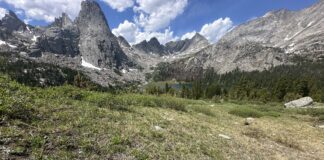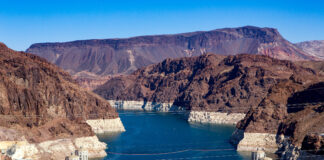
CARBONDALE — Proposition DD’s supporters — including environmental organizations, agriculture interests, conservation districts and Aspen Skiing Co. — say the measure will be used to close a $3 billion state funding gap in implementing the Colorado Water Plan. The frequently cited figure of a $100 million annual shortfall for 30 years is written in the water plan itself.
But where did the authors of the water plan get this number and what kinds of projects and programs might the measure fund? According to the legislation, money raised from Prop DD could go toward an agricultural water-use reduction program that doesn’t yet exist.
In the following explainer, Aspen Journalism unpacks the ballot question, which will be posed to voters Nov. 5, and what the tax revenue may actually end up funding.

How will Proposition DD work?
Gov. Jared Polis signed House Bill 19-1327 into law in May. But voters must still pass Proposition DD for it to take effect.
According to the 2019 State Ballot Information Booklet, Proposition DD would authorize the state to collect a 10% tax up to $29 million a year (but the projected average amount is $16 million) from casinos’ sports-betting proceeds. The Colorado Division of Gaming and the Colorado Limited Gaming Control Commission will be responsible for regulating sports betting operations.
Of the money raised, a projected $130,000 would go to gambling addiction services and $960,000 would go into a “hold harmless” fund. Entities that receive tax revenue from traditional gambling such as horse racing could apply for funding from the hold harmless fund if they can prove they lost money due to the legalization of sports betting.
The remaining projected average annual $14.9 million (but up to $27.2 million) in tax revenue would go to funding projects that align with the goals outlined in the water plan, as well as toward meeting interstate obligations such as the Colorado River Compact. Under the compact, the Upper Basin states, which include Colorado, must deliver 7.5 million acre-feet of water annually to Lake Powell.
If voters pass Proposition DD, it will take effect May 1.

What does the legislation say?
The legislation creates a special Water Plan Implementation Cash Fund, which would be administered by the Colorado Water Conservation Board, a statewide agency charged with managing Colorado’s water supply. The money could be spent on water-plan grants, but may also be spent “to ensure compliance with interstate water allocation compacts … including … compensation to water users for temporary and voluntary reductions in consumptive use.”
This language refers to a demand management program, the feasibility of which the state is currently studying.

What is demand management?
At the heart of a demand-management program is a reduction in water use by agriculture on a voluntary, temporary and compensated basis, all in an effort to send up to 500,000 acre-feet of water downstream to bolster water levels in Lake Powell to meet potential obligations under the Colorado River Compact. Under pilot programs the state could pay ranchers and farmers to leave more water in the river.
The CWCB has formed nine workgroups, each tasked with helping to identify and solve issues related to demand management. Western Slope agricultural water users have expressed concern about how a demand-management program would be implemented fairly.
District 5 State Sen. Kerry Donovan, whose district includes Aspen and who was a sponsor of the bill, acknowledged that as Colorado gets a handle on demand management, money from Proposition DD could go toward funding a future program.
“Most water experts would say demand management in some form will be part of addressing the Colorado River Compact obligations,” Donovan said. “Maybe in five years, maybe in the next generation, but somewhere in the long-term planning strategy of the Colorado River, demand management will be part of the puzzle.”

What is the Colorado Water Plan?
At the behest of then-Gov. John Hickenlooper, water managers from across Colorado collaboratively created the water plan, which was unveiled in 2015. The plan, which is more of a policy document, says Colorado faces a looming water “gap” across all sectors — municipal, industrial, agriculture, recreation and environment — because of the state’s growing population and increasing water demands.
The 567-page plan does not prescribe or endorse specific projects but instead sets Colorado’s water values, goals and measurable objectives, which are set out in a critical action plan. For example, the plan sets a measurable objective of storing an additional 400,000 acre-feet of water in reservoirs by 2050 and covering 80% of local rivers with stream-management plans by 2030, but it does not say how water managers should go about doing this.

What about water plan grants?
According to the legislation, revenue from Proposition DD will also go toward water-plan grants. Local water managers apply to the CWCB’s Water Plan Grant Program to fund projects that advance critical actions laid out in the water plan from the following categories: agricultural, engagement and innovation, environmental and recreation, water conservation and land-use planning, or water storage and supply.
Water-plan grants are a 50% matching grant, meaning that the local entities applying for the grant must match from their own coffers the amount they are requesting in state funds.
For fiscal year 2019-20, $10 million will be available for the Water Plan Grant Program. Funding from Proposition DD could add roughly $15 million a year to this grant program.
Many of the projects that the water-plan grants fund come from each of the nine basin roundtables’ Basin Implementation Plans. The BIPs identify how each basin’s water needs will be met through existing or new projects, policies and processes. But many of the local water projects included in the BIPs don’t specify how much funding is needed to implement them and many roundtables’ projects lists have only partial and inconsistent information.
For example, 14 of the 31 top projects outlined in the Colorado BIP have “TBD” in the Funding Needs column.
“In the Basin Implementation Plans, some of those projects are pretty rough and it was a best guess at the time with limited information,” said CWCB Deputy Director Lauren Ris.
Roundtables will soon embark on an update to their BIPs, with the goal of refining project details, including cost.

What is the funding gap?
According to the water plan, there is an estimated funding gap of $100 million per year over 30 years. These figures, according to Ris, came from data in the 2010 Statewide Water Supply Initiative. That technical analysis found that Colorado needed $20 billion worth of water projects to meet the water supply gap by 2050. Of that $20 billion, $17 billion is expected to be paid for by existing funding sources, including rate payers of water utilities and federal money.
The state is investigating options to fund the remaining $3 billion gap. Proposition DD is one of these options. But the $3 billion figure, based on decade-old data, is not precise.
“($100 million per year over 30 years) was an estimate,” Ris said. “I don’t think it was ever really intended to be an exact figure. It’s more to say, we know there’s going to be a big need and we will work to refine that estimate going forward … We are just trying to point out it’s an expensive endeavor going forward.”
Supporters of Proposition DD say they realize that the estimated $15 million raised per year is still a far cry from the estimated $100 million needed per year, instead calling the money a “down payment” on implementing the water plan.

Who is endorsing Proposition DD?
Proposition DD has received broad endorsement from environmental groups such as Conservation Colorado and American Rivers, agriculture organizations such as the Colorado Cattlemen’s Association and the Colorado Corn Growers Association, and several chambers of commerce.
The Colorado River Water Conservation District and Aspen Skiing Co. also support the measure.
Matt Rice of American Rivers said his organization is endorsing the measure because it wants to see some projects fully funded, including stream-management plans, urban water-conservation programs and modernization of agriculture irrigation infrastructure.
Rice said American Rivers “unabashedly and unequivocally” supports a demand-management program in Colorado, which Proposition DD could help fund.
“We deeply believe a demand-management program needs to be one of the tools that we have in our toolbox as we plan for water scarcity or prolonged drought because of climate change,” Rice said.

Who is opposed to Proposition DD?
Environmental group Save the Colorado and the political action committee Coloradans for Climate Justice oppose the measure. According to the Coloradans for Climate Justice Facebook page, the group believes fossil fuel companies should pay for the damage to water-supply systems caused by climate change. So far, the group has not filed any reports for contributions or expenditures.

Who is funding Proposition DD?
Despite broad support from many organizations, the political action committee Yes on Prop DD is funded primarily by the gambling industry. According to filings with the Secretary of State, as of Sept. 30, casinos and online sports betting organizations have spent nearly $1 million to support the measure. The Colorado Farm Bureau and the Environmental Defense Fund have contributed $10,000 each.
Editor’s note: Aspen Journalism is collaborating with The Aspen Times, Vail Daily, Summit Daily, Glenwood Springs Post-Independent and other Swift Communications newspapers on coverage of water and rivers. This story appeared in the Oct. 10, 2019 edition of the above papers or on their websites.
The Water Desk’s mission is to increase the volume, depth and power of journalism connected to Western water issues. We’re an initiative of the Center for Environmental Journalism at the University of Colorado Boulder. The Water Desk launched in April 2019 with support from the Walton Family Foundation. We maintain a strict editorial firewall between our funders and our journalism. The Water Desk is seeking additional funding to build and sustain the initiative. Click here to donate.





